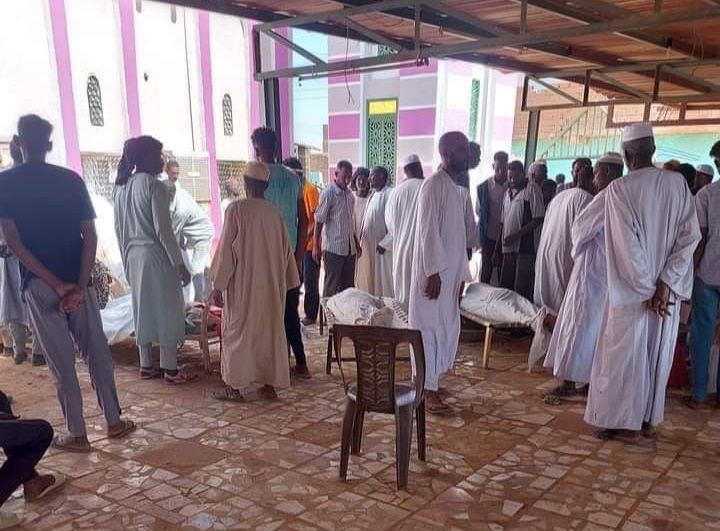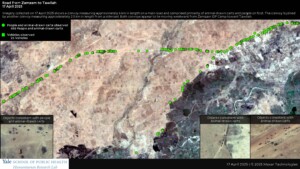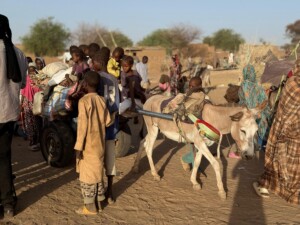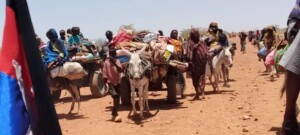Intense airstrikes on Sudan capital continue, army advancing in Omdurman

Funeral of victims killed in RSF-SAF battles in El Salama, southern Khartoum (Photo: Southern Belt Emergency Room via FB)
At least 11 people were killed in aerial bombardments in El Salama in southern Khartoum yesterday. The area in the vicinity of the El Sharaja military complex in Khartoum witnessed sporadic clashes between the army and the Rapid Support Forces (RSF), while army soldiers seem to advance in Omdurman. Sudan “ranks second among its regional neighbours in total firearms estimates,” a senior researcher at the Small Arms Survey reported last year.
The renewed fierce fighting between the Sudan Armed Forces (SAF) and the RSF in greater Khartoum continued in Khartoum yesterday.
The emergency room of Khartoum’s ‘southern belt’, set up by resistance committees in the area, reported that 10 people were fatally hit by artillery SAF attacks on RSF positions in El Salama yesterday morning.
This morning the bombing of El Salama continued, the neighbourhood’s resistance committees reported. A son of a man killed in the blasts yesterday, succumbed to his wounds this night.
The nearby neighbourhoods of El Azhari and Mayo were also bombarded yesterday. The intensive airstrikes were repelled by RSF anti-aircraft artillery.
People still living in eastern Khartoum, told Radio Dabanga that RSF sites in El Manshiya, Burri, and El Riyadh were attacked with SAF drones on Tuesday evening.
Radio Dabanga received also reports of SAF troops advancing in old (central) Omdurman and set up posts in Wad Nubawi, Hay El Arab, and near the Es Soug Esh Sha’abi market.
The RSF allegedly posted “video clips from El Arbaeen Street, the El Tijani El Mahi Hospital and the Omdurman municipality” on social media, while SAF supporters contradicted these with footage of army soldiers patrolling El Arbaeen Street and the El Morada Market.
Sudan War Monitor (SWM) reported yesterday that the intensified SAF attacks killed 23 people in Soba in southeast Khartoum on Tuesday. At least two people were injured in East Nile and 10 died in artillery attacks in El Salama yesterday.
Airpower
The army command is now headquartered in Port Sudan, and lost control of most of the capital, Khartoum, SWM commented. “It uses a fleet of Antonov transport planes, Sukhoi and MiG fighters, and some helicopters. By contrast, RSF have no air force, but they have won most of the ground battles of the war.”
Since the war between the Sudanese army and its paramilitary counterpart, the RSF, on April 15 last year, the RSF took control of most of greater Khartoum. “The Sudanese army’s infantry battalions have hardly been present on the streets of Khartoum during the two months-long conflict,” the BBC said on June 24.
“This is despite the fact that the army is made up of about 200,000 soldiers, roughly twice the size of the RSF. [..] With its airpower being its greatest strength, the military has been constantly carrying out strikes to weaken the RSF. Although they are believed to have killed hundreds of civilians, they have not prevented the paramilitaries from advancing in Khartoum, Bahri and Omdurman.”
‘Awash’
An article written by Khristopher Carlson, senior researcher at the Small Arms Survey in The Conversation in May last year, “shows that the two armed forces in Sudan employ strikingly contrasting fighting methods – both with flagrant disregard for the safety of the population,” the Geneva Graduate Institute explained.
“Sudan is awash with firearms,” Carlson stated. “The country ranks second among its regional neighbours in total firearms estimates, with combined holdings among civilians and security forces topping out at over three million.
“The Sudanese army has in excess of 120,000 troops countrywide – with several thousand more in reserve. Its recruits are primarily from the country’s peripheries, while its leadership is comprised largely of elites from the central Nile region. The army’s capability is bolstered by its air force and supported by battle tanks and other armoured infantry vehicles.
“The Rapid Support Forces have more than 75,000 combatants, most of whom hail from the Darfur region in the country’s far west. The force is buttressed by additional recruits in Sudan’s north and east.
Several militia groups aligned with the paramilitary force’s commander, Mohamed ‘Hemedti’ Dagalo, could mobilise if conflict intensifies in Sudan’s peripheries, particularly in Darfur, the researcher warns.
As for the Sudanese capital, RSF fighters in Khartoum, “which has seen the most sustained and concentrated fighting, are relying on small arms and heavy machine guns to control the airport and government buildings, and to hold positions wedged between residential apartment blocks.
“These paramilitary fighters have an abundance of AK-pattern rifles and more sophisticated high-calibre weapons. Since former President Omar Bashir’s ouster in 2019 and Hemedti’s rise as deputy leader of Sudan’s government, he’s been relatively unencumbered in procuring weapons and equipment for his force.
“A 2019 investigation revealed that more than 1,000 vehicles – most of them Toyota Hilux pick-ups – were purchased from dealers in the United Arab Emirates, and later equipped with mounted weapons. The funds to purchase the vehicles were likely sourced from Hemedti’s vast gold mining operations in Sudan,” Carlson stated.
In 2015, Sudan was considered the third largest weapons manufacturer in Africa, after Egypt and South Africa. In February that year, Sudan displayed a wide range of arms and military equipment produced by the state-owned Military Industry Corporation (MIC) at the International Defence Exhibition and Conference (Idex) in Abu Dhabi.
Allies
“Regional powers have picked sides,” Sudanese policy analyst Kholood Khair and civil society activist Asmahan Akam confirmed in early December.
“Egypt, Iran, Turkey, and Saudi Arabia support the SAF while the UAE, a UN Security Council member, backs the RSF in seeming violation of the body’s own arms embargo on Darfur, first enacted in 2004 and just renewed (with a yes vote from the UAE) in March 2023.”
The UAE has denied supplying weapons or ammunition to the RSF.
Hemedti seems to be politically backed by a number of African countries, as he has been welcomed, in Kenya even as an official statesman, by several African presidents during his recent tour through the continent.











 and then
and then